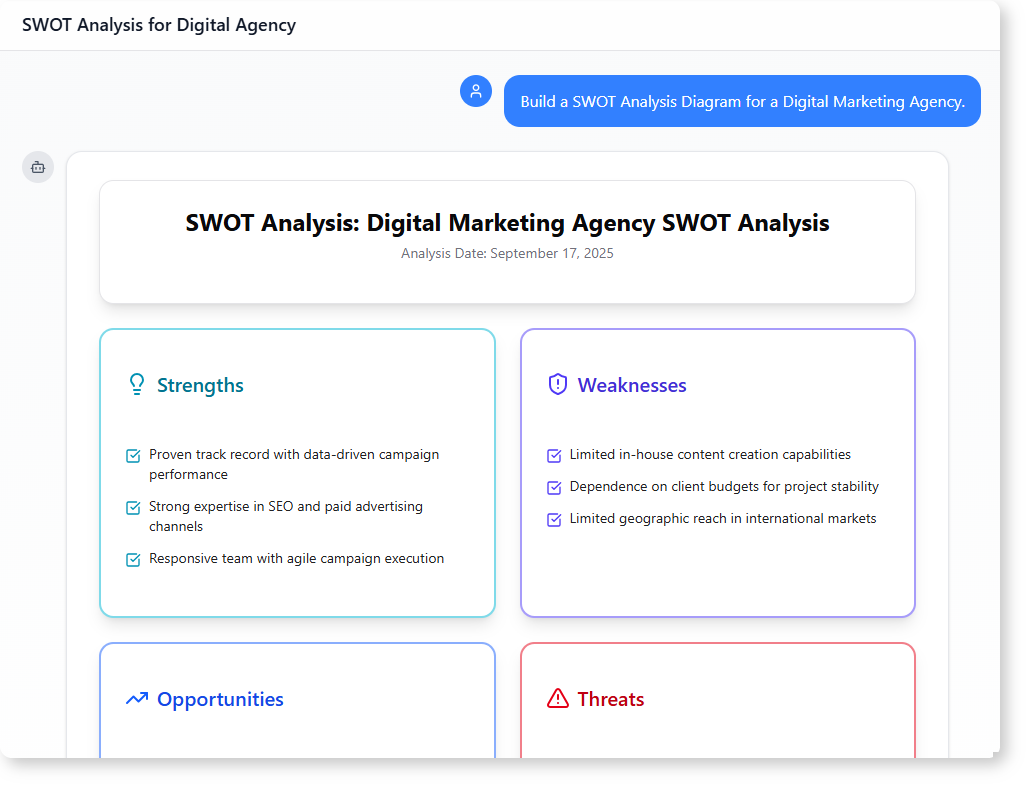Now Reading: How to Generate a SWOT Analysis for a Digital Marketing Agency with AI-Powered Modeling Software
-
01
How to Generate a SWOT Analysis for a Digital Marketing Agency with AI-Powered Modeling Software
How to Generate a SWOT Analysis for a Digital Marketing Agency with AI-Powered Modeling Software
How a Digital Marketing Agency Can Use AI-Powered Modeling Software to Build a SWOT Analysis
A small digital marketing agency is looking to assess its current market position. The team knows they have strengths in SEO and campaign performance, but they’re unsure how to clearly map out their internal challenges or growth opportunities.
They decide to use an AI-powered modeling software to generate a SWOT analysis—specifically a SWOT diagram software that turns descriptive content into a structured, visual report. This helps them present the findings to stakeholders who aren’t familiar with internal operations.
The process is simple, but the outcome is valuable. Instead of spending hours organizing data manually, they get a clear, ready-to-share SWOT analysis that explains their competitive landscape.

The User’s Journey: From Prompt to Insight
The user begins by asking the AI-powered modeling software to build a SWOT analysis for a digital marketing agency. This prompt triggers the system to generate a detailed diagram based on industry patterns and the agency’s stated capabilities.
They then follow up with a second request: to prepare a descriptive report that explains the diagram to someone with no prior exposure to SWOT frameworks. This ensures the analysis is not just visual—but also understandable.
The flow of the interaction is natural and effective:
-
Prompt: “Build a SWOT Analysis Diagram for a Digital Marketing Agency.”
- The AI interprets the request and creates a structured SWOT diagram covering strengths, weaknesses, opportunities, and threats.
-
Clarification: “Prepare a descriptive report that explains the diagram for someone who has not seen it before.”
- The AI translates the diagram into plain language, breaking down each section with real-world context.
This two-step process ensures both accuracy and accessibility. The result is not just a diagram—it’s a complete understanding of the agency’s competitive position.
What the AI-Powered Modeling Software Delivers
The output goes beyond a static chart. It provides:
- A clear, organized breakdown of the agency’s internal and external factors.
- Real-world context for each element—like how rising AI tools in marketing represent a major opportunity.
- A balanced view that doesn’t just highlight wins, but also flags risks like client churn or geographic limitations.
Here’s what the SWOT analysis reveals:
Strengths
- Proven track record with data-driven campaign performance
- Strong expertise in SEO and paid advertising channels
- Responsive team with agile campaign execution
Weaknesses
- Limited in-house content creation capabilities
- Dependence on client budgets for project stability
- Limited geographic reach in international markets
Opportunities
- Rise in demand for AI-powered marketing tools
- Expansion into niche verticals like healthcare or education
- Growing interest in video and influencer marketing
Threats
- Intensifying competition from low-cost agencies
- Fast-evolving digital trends requiring constant learning
- Client churn due to changing marketing preferences
Each point is grounded in actual market dynamics. For example, the mention of AI-powered tools doesn’t just sound futuristic—it reflects a real shift in how marketing agencies are being evaluated.
Why This Matters for Business Teams
Many teams rely on spreadsheets or manual notes to evaluate their position. That approach can miss key patterns or lead to incomplete insights.
An AI-powered modeling tool helps by:
- Turning abstract ideas into visual frameworks
- Generating reports that explain complex data in simple terms
- Supporting strategic discussions with clear, factual content
This is especially useful when presenting to executives or clients who don’t have a background in business analysis.
How to Use This Approach in Your Own Work
If you’re running a service-based business, consider using AI-powered modeling software to evaluate your own position.
Start by defining your core activities and market exposure. Then ask:
- What are our key strengths?
- Where are we lacking?
- What trends could open new doors?
- What external forces could challenge us?
Then, use the tool to turn those thoughts into a clear, shareable SWOT analysis.
The result is not just a document—it’s a conversation starter. It helps teams align on goals, spot risks, and explore new directions.
Frequently Asked Questions
Q: Can AI modeling software generate a SWOT diagram for any type of business?
A: Yes. The AI-powered modeling software is designed to interpret business context and produce relevant SWOT elements. Whether it’s a digital marketing agency or a software startup, the tool adapts the content to fit the industry.
Q: Is the SWOT analysis generated by the AI accurate?
A: The output is based on real-world patterns and common challenges within the industry. While it reflects typical business dynamics, it’s not a substitute for deep internal review. It serves as a starting point for discussion.
Q: Can I explain the SWOT analysis to someone unfamiliar with the topic?
A: Absolutely. The tool includes a descriptive report that turns technical terms into everyday language, making it easy to share with non-technical stakeholders.
Q: Is this tool suitable for agencies or service providers?
A: Yes. It’s especially helpful for service-based businesses that need to show market positioning, track performance, or plan for growth.
Ready to map out your system’s interactions? Give our AI-powered modeling software a try at Visual Paradigm’s AI Chatbot today!
